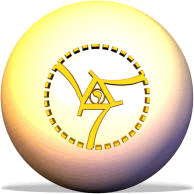Page Back to: EARTH ANGELS
Inspired Organizations
The organizations below are all active in helping the world. They all contribute in different ways. Some as charities relieving the suffering in the world, while others actively work to change the world. ALL of them are examples of being part of the solution. In the video there are several organizations featured, but before we address these, we need to understand that several individuals will be featured in more than one category. For instance President Carter is included in Inspired Organizations for The Carter Center Foundation and for his Nobel Peace Prize award in 2002. President Clinton is featured three times; for AmeriCorps, The William J. Clinton Foundation, and also in the Inspired Authors for his book Giving: How Each of Us Can Change The World (click below to view each entry).
- NOOW– Not On Our Watch: Darfur; founded by Brad Pitt, Matt Damon, George Clooney, Don Cheadle and Jerry Weintraub
- Doctors Without Borders– (MSF) Humanitarian organization that brings medical help and assistance to areas of disaster, war and famine
- PlayPumps®Water System– Organization, which provides clean water to remote areas in Africa through children playing on a roundabout
- Lawrence’s Roundabout Well Appeal– Charity that raises money for playpumps in Africa
- One Campaign– Organization that brings governments, NGOs, celebrities, and charitable organizations together to end World Poverty
- Peace Corps– volunteer organization instigated by John F. Kennedy that encourages students and young people to go to third world countries for humanitarian programs
- AmeriCorp– volunteer organization set up by President Bill Clinton to help with disasters and other humanitarian programs
- UNICEF United Nation’s Children’s Fund– International charity, which focuses on programs for the needs of the World’s children
- The William J. Clinton Foundation– Organization, which brings together people in need and donors to engage in programs of assistance
- The Carter Center– Foundation that works with multiple organizations, governments and charities to promote Peace
- Wikipedia– Free online Encyclopedia that brings the world’s knowledge together in one data base & GNU Free Documentation License
- SUBMITTALS by Sherri Zimmerman– The Musser Foundation -&-
Jim De Maio—Helping Ministry
YOU CAN HELP US ADD OTHERS TO THE LIST: GO TO MAIN EARTH ANGEL PAGE TO LEARN HOW
NOOW
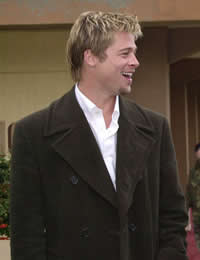
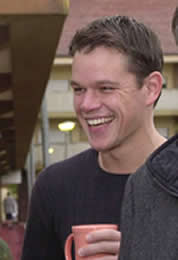
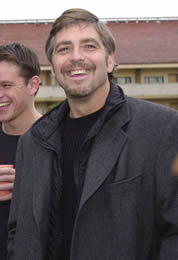
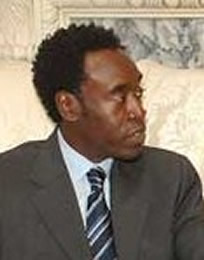
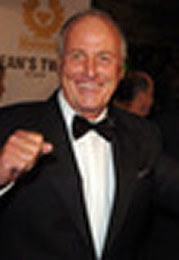
From left to right - Brad Pitt, Matt Damon, George Clooney, Don Cheadle and Jerry Weintraub
On their web site NOT ON OUR WATCH www.notonourwatchproject.org: DARFUR they state their mission in several steps. First, their mission “is to focus global attention and resources to stop and prevent mass atrocities.” Drawing on the powerful voice of citizen artists, activists, and cultural leaders, “our mission is to generate lifesaving humanitarian assistance and protection for the vulnerable, marginalized, and displaced.”
They go on to say why they formed the organization, by stating “Several of our board members have personally witnessed the carnage and catastrophe that is Darfur. Every day the situation is deteriorating. The increase in violence has put the humanitarian life-support system on life-support itself. It is our aim to support existing humanitarian relief efforts and to ensure the protection of civilians in Darfur by:
ADVOCATING FOR ACTION. Not On Our Watch will work to focus international attention on the continuing carnage in Darfur, encouraging governments and international organizations to take meaningful action to protect the vulnerable, marginalized, and displaced.’ Where governments have remained silent, we are committed to working to render otherwise invisible atrocities, visible.
SAVING LIVES. Public health in Darfur has rapidly declined; death and disease have skyrocketed. In the midst of conflict, Not On Our Watch is committed to supporting existing organizations’ efforts to provide clean water and basic health care to treat diseases and prevent their spread.
SHELTERING FAMILIES AND BUILDING COMMUNITY. The displaced and vulnerable are regularly exposed to harsh weather conditions making survival difficult at best. Not On Our Watch will make strategic grants to organizations providing shelter to families and psychosocial care to survivors helping them regain and rebuild a sense of community.
HELPING CHILDREN COPE WITH CONFLICT. Children in the Darfur region have experienced tremendous trauma and remain particularly vulnerable. Not On Our Watch is committed to supporting efforts to allow children to be children, even in the midst of conflict. We will fund programs, through established organizations, that create safe spaces for children to play and learn. Our educational grants will target literacy, math, vocational and health education programs, HIV/AIDS prevention, and peace-building activities.
EMPOWERING WOMEN. Systematic rape and sexual violence against women and girls is a weapon of choice in Darfur. Not On Our Watch is committed to supporting efforts to provide survivors with vocational skills, legal assistance, medical care, and counseling.
PROTECTING THE PROTECTORS AND PROMOTING HUMAN RIGHTS. Civilians in Darfur continue to lack any meaningful protection. We are committed to supporting organizations that train community leaders and local officials in international human rights norms and civilian protection principles. With the safety of humanitarian aid workers in constant jeopardy, we will support efforts of humanitarian organizations to protect their staff from harassment and attack.
Back to List at Top of Page
DOCTORS WITHOUT BORDERS (MSF)-USA / Medecins Sans Frontieres (MSF)

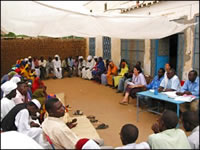
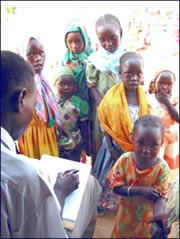
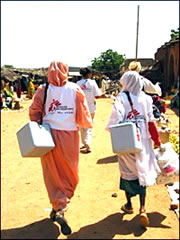
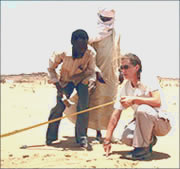
MSF in Africa
We were pleased and honored to include short clips from Doctors Without Borders (MSF)-USA www.doctorswithoutborders.org MSF in refugee camps in Chad, Africa in the video. Fittingly, MSF was awarded the Nobel Peace Prize in 1999, as an article on Wikipedia relates, “in recognition of its members’ continuous effort to provide medical care in acute crises, as well as raising international awareness of potential humanitarian disasters”. The Wikipedia article gives a comprehensive article on this important Inspired Organization. Because MSF was present in most of the situations depicted in the first half of the video, as well as representing the solution in the second half of the video, we feel it is appropriate to give a thorough account of the work this Inspired Organization has done. As stated, the article in Wikipedia was our source:
The Groupe d'Intervention Médicale et Chirurgicale en Urgence (“Emergency Medical and Surgical Intervention Group”) was formed in 1970 by French doctors who had worked in Biafra, to provide aid and to emphasize the importance of victims’ rights over neutrality. At the same time, Raymond Borel, the editor of the French medical journal TONUS, had started a group called Secours Médical Français (“French Medical Relief”) in response to the 1970 Bhola cyclone, which killed at least 500,000 in East Pakistan (now Bangladesh). Borel had intended to recruit doctors to provide aid to victims of natural disasters. On 20 December 1971, the two groups of colleagues merged to form Médecins Sans Frontières.
MSF’s first mission as an independent aid organization was to the Nicaraguan capital, Managua, where a 23 December 1972 earthquake had destroyed most of the city and killed between 10,000 and 30,000 people. The organization, today known for its quick response in an emergency, arrived three days after the Red Cross had set up a relief mission. On 18 September and 19 September 1974, Hurricane Fifi caused major flooding in Honduras and killed thousands of people (estimates vary), and MSF set up its first long-term medical relief mission.
Between 1975 and 1979, after South Vietnam had fallen to North Vietnam, there was the emigration of millions of Cambodians to Thailand to avoid the Khmer Rouge. In response MSF set up its first refugee camp missions in Thailand. When Vietnam withdrew from Cambodia in 1989, MSF started long-term relief missions to help survivors of the mass killings and reconstruct the country’s health care system. Although its missions to Thailand to help victims of war in South east Asia could arguably be seen as its first war-time mission, MSF saw its first mission to a true war zone, including exposure to hostile fire, in 1976. MSF spent nine years (1976–1984) assisting surgeries in the hospitals of various cities in Lebanon during the Lebanese Civil War, and established a reputation for its neutrality and its willingness to work under fire. Throughout the war, MSF helped both Christian and Muslim soldiers alike, assisting whichever group required the most medical aid at the time…
In 1982, Malhuret and Rony Brauman (who would become the organisation’s president in 1982), brought increased financial independence to MSF by introducing fundraising-by-mail to better collect donations. The 1980s also saw the establishment of the other operational sections from MSF-France (1971): MSF-Belgium (1980), MSF-Switzerland (1981), MSF-Holland (1984), and MSF-Spain (1986). MSF-Luxembourg was the first support section, created in 1986. The early 1990s saw the establishment of the majority of the support sections: MSF-Greece (1990), MSF-USA (1990), MSF-Canada (1991), MSF-Japan (1992), MSF-UK (1993), MSF-Italy (1993), MSF-Australia (1994), as well as Germany, Austria, Denmark, Sweden, Norway, and Hong Kong (MSF-UAE was formed later)…In December 1979, after the Soviet army had invaded Afghanistan, field missions were immediately set up to provide medical aid to the mujahideen, and in February 1980, MSF publicly denounced the Khmer Rouge. During the 1984 – 1985 famine in Ethiopia, MSF set up nutrition programmes in the country in 1984, but was expelled in 1985 after denouncing the abuse of international aid and the forced resettlements. The group also set up equipment to produce clean drinking water for the population of San Salvador, capital of El Salvador, after the October 10, 1986 earthquake that struck the city.
In 1979, MSF set up missions to help civilians in southern Sudan affected by starvation and the ongoing civil war. MSF volunteers revealed many personal accounts of the horrors they had witnessed, including tortures, mass executions, cannibalism, and large-scale starvation and disease, and in 1989 two volunteers were killed when their plane was shot down. MSF has maintained relief efforts in Sudan for 25 years, despite arrests of their volunteers, nearly constant fighting and civilian massacres, famine, drought, poor sanitation, and outbreaks of tuberculosis, ebola, hepatitis E, polio, cholera, and malaria (among others, and all have the potential for epidemics)…
The early 1990s saw MSF open a number of new national sections, and at the same time, set up field missions in some of the most dangerous and distressing situations it had ever encountered.
In 1990, MSF first entered Liberia to help civilians and refugees affected by the Liberian Civil War. Constant fighting throughout the 1990s and the Second Liberian Civil War have kept MSF volunteers actively providing nutrition, basic health care, and mass vaccinations, and speaking out against attacks on hospitals and feeding stations, especially in Monrovia.
Field missions were set up to provide relief to Kurdish refugees who had survived the al-Anfal Campaign, for which evidence of atrocities was being collected in 1991. 1991 also saw the beginning of the Somali Civil War, and widespread famine and disease, for which MSF set up field missions in 1992. Failed United Nations interventions led to greater violence, and MSF denounced the organisation’s operation in 1993, but volunteers continued to provide health care and food. Since the United Nations left, violence in Somalia has been unhindered, and MSF is one of the few organisations helping affected civilians by running clinics and hospitals.
MSF first began work in Srebrenica (in Boznia and Herzegovina) as part of a UN convoy in 1993; one year after the Bosnian War had begun. The city had become surrounded by the Bosnian Serb Army and, containing about 60,000 Bosniaks, had become an enclave guarded by a United Nations Protection Force. MSF was the only organisation providing medical care to the surrounded civilians, and as such, did not denounce the genocide for fear of being expelled from the country (it did, however, denounce the lack of access for other organisations). MSF was forced to leave the area in 1995, when the Bosnian Serb Army captured the town, deported the majority of the inhabitants, and killed approximately 8,000.
When the genocide in Rawanda began in April 1994, some delegates of MSF working in the country were incorporated into the ICRC medical team for protection. Both groups succeeded in keeping all main hospitals in Rwanda’s capital Kigali operational throughout the main period of the genocide…The ICRC lost 56 and MSF lost almost one hundred of their respective local staff in Rwanda, and MSF-France, which had chosen to evacuate its team from the country (the local staff were forced to stay), denounced the murders and demanded that a French military intervention stop the genocide…
In the late 1990s, MSF missions were set up to treat tuberculosis and anaemia in residents of the Aral Sea area, and look after civilians affected by drug-resistant disease, famine, and epidemics of cholera and AIDS. They vaccinated 3 million Nigerians against meningitis during an epidemic in 1996 and denounced the Taliban’s neglect of health care for women in 1997. Arguably, the most significant country in which MSF set up field missions in the late 1990s was Sierra Leone, which was involved in a civil war at the time. In 1998, volunteers began assisting in surgeries in Freetown to help with an increasing number of amputees, and collecting statistics on civilians (men, women and children) being attacked by large groups of men claiming to represent ECOMOG. The groups of men were travelling between villages and systematically chopping off one or both of each resident’s arms, raping women, gunning down families, razing houses, and forcing survivors to leave the area. Long-term projects following the end of the civil war included psychological support and phantom limb pain management.
The Campaign for Access to Essential Medicines was created in late 1999, providing MSF with a new voice with which to bring awareness to the lack of effective treatments and vaccines available in developing countries. In 1999 the organisation also spoke out about the lack of humanitarian support in Kosovo and Chechnya, having set up field missions to help civilians affected by the respective political situations. Although MSF had worked in the Kosovo region since 1993, the onset of the Kosovo War prompted the movement of tens of thousands of refugees, and a decline in suitable living conditions. MSF provided shelter, water and health care to civilians affected by NATO’s strategic bombing campaigns. A similar situation was found in Chechnya, whose civilian population was largely forced from their homes into unhealthy conditions and subjected to the violence of the Second Chechen War.
Columbia is another country in which war has directly affected civilians, and MSF first set up programmes in that country in 1985. With almost constant fighting between government forces, guerrilla groups such as FARC and paramilitary groups such as AUC, millions of civilians have been displaced from their homes, and domestic violence and abductions are common. MSF has largely been active in providing counsel for people troubled by the violence, as well as setting up health facilities for the large groups of displaced people and using mobile clinics to help isolated groups.
MSF has been working in Haiti since 1991, but since President Jean-Bertrand Aristide was forced from power, the country has seen a large increase in civilian attacks and rape by armed groups. In addition to providing surgical and psychological support in existing hospitals - offering the only free surgery available in Port-au-Prince - field missions have been set up to rebuild water and waste management systems and treat survivors of major flooding caused by Hurricane Jeanne; patients with HIV/AIDS and malaria, both of which are widespread in the country, also receive better treatment and monitoring.
The Kashmir Conflict in northern India has resulted in a more recent MSF intervention (the first field mission was set up in 1999) to help civilians displaced by fighting…Psychological support is a major target of missions, but teams have also set up programmes to treat tuberculosis, HIV/AIDS and malaria. Mental health support has been of significant importance for MSF in much of southern Asia since the 2004 Indian Ocean earthquake.
MSF has been active in a large number of African countries for decades, sometimes serving as the sole provider of health care, food, and water. Although MSF has consistently attempted to increase media coverage of the situation in Africa to increase international support, long-term field missions are still necessary. Treating and educating the public about HIV/AIDS in sub-Saharan Africa, which sees the most deaths and cases of the disease in the world, is a major task for volunteers. Only 4% of Africans with HIV/AIDS are receiving anti-retroviral treatment, and MSF is urging governments and companies to increase research and development into HIV/AIDS treatments to decrease cost and increase availability.
Although active in the Congo region of Africa since 1985, the First and Second Congo War brought increased violence and instability to the area. MSF has had to evacuate its teams from areas such as around Bunia, in the Ituri district due to extreme violence, but continues to work in other areas to provide food to tens of thousands of displaced civilians, as well as treat survivors of mass rapes and widespread fighting. The treatment and possible vaccination against diseases such as cholera, measles, polio, Marburg fever, sleeping sickness, HIV/AIDS, and Bubonic plague is also important to prevent or slow down epidemics.
MSF has been active in Uganda since 1980, and provided relief to civilians during the country’s guerrilla war during the Second Obote Period. However, the formation of the Lord’s Resistance Army saw the beginning of a long campaign of violence in northern Uganda and southern Sudan. Civilians were subjected to mass killings and rapes, torture, and abductions of children, who would later serve as sex slaves or child soldiers. Faced more than 1.5 million people displaced from their homes, MSF set up relief programmes in internally displaced person camps to provide clean water, food and sanitation. Diseases such as tuberculosis, measles, polio, cholera, ebola, and HIV/AIDS occur in epidemics in the country, and volunteers provide vaccinations (in the cases of measles and polio) and/or treatment to the residents. Mental health is also an important aspect of medical treatment for MSF teams in Uganda, since most people refuse to leave the IDP camps for constant fear of being attacked…
A field mission team usually consists of a small number of coordinators to head each component of a field mission, and a “head of mission.” The head of mission usually has the most experience in humanitarian situations of the members of the team, and it is his/her job to deal with the media, national governments and other humanitarian organisations.
Medical volunteers include physicians, surgeons, nurses, and various other specialists, all of whom usually have training in tropical medicine and epidemiology. In addition to operating the medical and nutrition components of the field mission, these volunteers are sometimes in charge of a group of local medical staff and provide training for them.
Although the medical volunteers almost always receive the most media attention when the world becomes aware of an MSF field mission, there are a number of non-medical volunteers who help keep the field mission functioning. Logisticians are often the most important members of a team. They are responsible for providing everything that the medical component of a mission needs, ranging from security and vehicle maintenance to food and electricity supplies. They may be engineers and/or foremen, but they usually also help with setting up treatment centres and supervising local staff. Other non-medical staff are water/sanitation specialists, who are usually experienced engineers in the fields of water treatment and management and financial/administration experts who are placed with field missions.
Vaccination campaigns are a major part of the medical care provided during MSF missions. Diseases such as diphtheria, measles, meningitis, tetanus, pertussis, yellow fever, polio, and cholera, all of which are uncommon in developed countries, may be prevented with vaccination. Some of these diseases, such as cholera and measles, spread rapidly in large populations living in close proximity, such as in a refugee camp, and people must be immunised by the hundreds or thousands in a short period of time. For example in Beira Mozambique in 2004, an experimental cholera vaccine was received twice by approximately 50,000 residents in about one month.
An equally important part of the medical care provided during MSF missions is AIDS treatment (with antiretroviral drugs), AIDS testing, and education. MSF is the only source of treatment for many countries in Africa, whose citizens make up the majority of people with HIV and AIDS world-wide. Because antiretroviral drugs (ARVs) are not readily available, MSF usually provides treatment for opportunistic infections and educates the public on how to slow transmission of the disease.
In most countries, MSF increases the capabilities of local hospitals by improving sanitation, providing equipment and drugs, and training local hospital staff. When the local staff is overwhelmed, MSF may open new specialised clinics for treatment of an endemic disease or surgery for victims of war. International staff start these clinics but MSF strives to increase the local staff's ability to run the clinics themselves through training and supervision. In some countries, like Nicaragua, MSF provides public education to increase awareness of reproductive health care and venereal disease.
Since most of the areas that require field missions have been affected by a natural disaster, civil war, or endemic disease, the residents usually require psychological support as well. Although the presence of an MSF medical team may decrease stress somewhat among victims, often a team of psychologists or psychiatrists work with victims of depression, domestic violence and substance abuse. The doctors may also train local mental health staff.
Often in situations where an MSF mission is set up, there is moderate or severe malnutrition as a result of war, drought, or government economic mismanagement. Intentional starvation is also sometimes used during a war as a weapon, and MSF, in addition to providing food, brings awareness to the situation and insists on foreign government intervention. Infectious diseases and diarrhoea, both of which cause weight loss and weakening of a person’s body (especially in children), must be treated with medication and proper nutrition to prevent further infections and weight loss. A combination of the above situations, as when a civil war is fought during times of drought and infectious disease outbreaks, can create famine…
Back to List at Top of Page
PLAYPUMPS® WATER SYSTEM
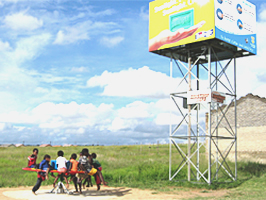
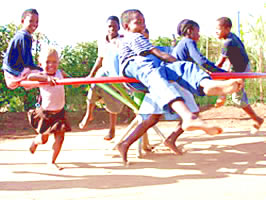
Children in Africa playing on roundabout, which pumps water into a holding tank
We had heard about the play pumps in Africa some time ago and wanted to acknowledge this brilliant, but simple idea to bring clean water to remote villages in Africa. The story of the play pumps is a fascinating tale of inspiration. On the web site www.playpumps.org is the history and development of the PlayPump® Water System. In their own words they say:
One summer day in 1989, on a whim, Trevor Field and his father-in-law visited an agricultural fair outside of Johannesburg, South Africa. There they stumbled upon an inspirational machine with the potential to transform millions of lives.
Nestled among displays of giant produce, superior animals and farm equipment they discovered a child’s roundabout, or merry-go-round, attached to a water pump. As it turned, water pumped from beneath the ground into the field. This simple pump was being displayed by an engineer and professional borehole-driller, who dreamt of designing a tool that would both delight and help the rural children who often gathered to watch his drilling machinery at work, children who had boundless energy and few outlets for play.
As Trevor, a veteran advertising executive spun the idea around in his head; he saw how to turn this simple pump into a more complex water system. He pictured adding a high-capacity water storage tank and four billboard spaces for both advertising and powerful public education messages. Where everyone else saw a merry-go-round that pumped water, Trevor saw advertising billboards that pumped water. Suddenly, Trevor turned this simple pump into an innovative, sustainable, child-friendly answer to one of the region’s most pressing problems, the need for more clean drinking water.
For collaboration, Trevor reached out to his longtime business colleagues, Paolo Ristic and Sarel Nienaber. Together they licensed the concept from its inventor and launched Roundabout Outdoor, a company with a social mission, dedicated to this new product, the PlayPump® water system. They revised the pump’s features and created a business plan. Their innovative business model would use donations to underwrite the merry-go-round pump head, with its sealed water storage tank, water tap stand, concrete water spillage runoff and borehole, melding those with advertising revenue to fund maintenance, guaranteeing sustainability. The PlayPump water pumping system was born.
At first, it was a small venture. Trevor’s wife – a therapist, not an engineer herself -- oversaw the first two pump installations in 1994 in South Africa’s Masinga District, the most remote area of KwaZulu-Natal Province, simply because Trevor couldn’t spare the travel days from his regular job. Umgeni Water Company sponsored the manufacture and installation of the pump; Colgate-Palmolive advertised toothpaste on the storage tank’s boards. By 1997, almost nine years after discovering the pump and creating the system, they had installed 20 PlayPump systems in South Africa, with plans to install 50 more.
The turning point for the PlayPump “system came late in 1999. President Nelson Mandela attended the ceremonial opening of a new school with a new PlayPump system.” When that story hit the newspapers, Roundabout Outdoor picked up speed.
Early in 2000, Roundabout Outdoor won the prestigious World Bank Development Marketplace Award for its ability to deliver both water and powerful HIV/AIDS prevention messages. The funds and visibility from the award enabled the PlayPump system to scale up at a much faster rate. Roundabout Outdoor created a South African NGO to facilitate partnerships with corporations, foundations, governments and individuals; that organization is now called PlayPumps International and is also incorporated as a U.S. nonprofit organization.
The Henry J. Kaiser Family Foundation provided PlayPumps International with its first large grant, stipulating that it raise matching funds through the South African Department of Water Affairs and Forestry. PlayPumps International quickly forged this partnership, intent on helping the Ministry fulfill its goal to deliver water to all of South Africa by 2008. Eskom, the South African electricity supply company, also came on board. Together, Eskom, the Water Affairs Department, and Roundabout Outdoor won a Mail & Guardian. Investing in the Future Award in 2003 as a best-practices example of a partnership offering innovation and social relevance. In 2005, the Alcan Prize for Sustainability recognized Roundabout Outdoor as one of its top 10 finalists.
PlayPumps International and the Roundabout team are now “expanding their reach.” More than 900 PlayPump systems have been installed in South Africa, Mozambique, “Swaziland,” and Zambia. “Moving into new countries is proving the viability of the PlayPump® water system and business model for sub-Saharan Africa.
In the coming years, PlayPumps International and Roundabout Outdoor will expand operations in Southern Africa. “More countries in East Africa will follow. In total, 4000 PlayPump water” systems will bring the benefits of clean drinking water to up to “10 million people in 10 countries by 2010, enabling improvements in health, education, gender equality and economic development.
Back to List at Top of Page
LAWRENCE’S ROUNDABOUT WELL APPEAL

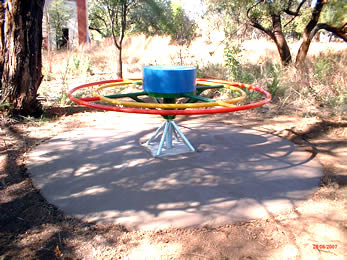
From left to right – Laurence Prifti – the playpump roundabout the charity raised the money for in Lawrence’s memory
Initially, when we researched the play pumps, we came across the young boy Lawrence Prifti’s site www.lawrencesroundaboutwellappeal.org and learned that he was a young boy who tragically died in 2005 of a very rare genetic disease. However the reason his picture was placed next to the picture of the play pump roundabout was because, the parents of Lawrence wanted his life to count for something and consequently set up a charity raising money for play pumps in Africa. We applaud his parents as they say on the web site “the life of one child will be remembered by changing the lives of many.” We cannot think of a better way to celebrate the life of your little boy.
Back to List at Top of Page
ONE CAMPAIGN
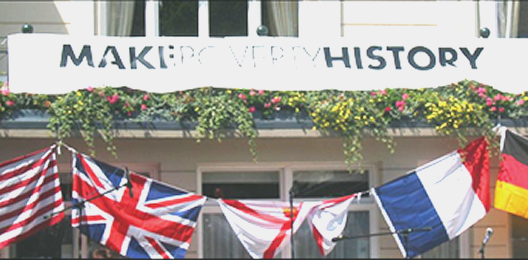
Banner advocating the world unites to end poverty
ONE www.one.org is featured in the video in many ways. Predominantly through its celebrity partners, however, as it’s goal is to end poverty, we could not think of a more appropriate image to recognize this Inspired Organization. Again, we turned to Wikipedia to find the information for this entry:
ONE is a grassroots organization which attempts to mobilize supporters around its issues and organize them into a lobbying force, with the goal of encouraging America’s elected national leaders to fund more of the U.S’s international development and relief programs. As a campaign to fight extreme poverty and global diseases, it supports the Millennium Development Goals.
Although its central talking points center on ending extreme poverty and fighting the AIDS pandemic, ONE supports a broad variety of international development and relief issues, including debt relief, clean water, increasing the quantity and efficiency of aid, lessening corruption in the governments of the aid-recipient countries, providing basic education for all, making trade more fair, reforming the farm bill to make it more fair for farmers in developing countries, slowing deadly diseases such as HIV/AIDS, malaria, and tuberculosis, and increasing the international affairs budget in general. ONE also holds the position that increasing foreign development assistance will create a more secure world, believing that global poverty and the ideological extremism that fuels terrorism are linked.
ONE claims that increasing international assistance by an amount equal to one percent of the U.S. budget will:
- Reduce by half the number of people in the world who suffer from hunger.
- Provide free access to primary education for 77 million out-of-school children.
- Provide access to clean water to 450 million people and basic sanitation to 700 million people.
- Prevent 5.4 million young children from dying of poverty-related illnesses each year.
- Save 16,000 lives a day by fighting HIV/AIDS, Tuberculosis and Malaria.
ONE was founded by 11 organizations: Bread for the World, Cooperative for Assistance and Relief Everywhere (CARE), DATA, International Medical Corps, International Rescue Committee, Mercy Corps, Oxfam America, Plan USA, Save the Children US, World Concern, World Vision.
There was an official launch on May 16, 2004 at Liberty Mall in Philadelphia. About 2,000 people attended the rally, including Bono, Dikembe Mutombo, Michael W. Smith, Richard Stearns (President of World Vision), and David Beckmann (President of Bread for the World).
In December, ONE announced a $3 million grant from the Bill & Melinda Gates Foundation. Corresponding with this announcement, ONE tried to show the bi-partisan nature of its campaign by having Mark McKinnon, an advisor to President Bush, and Mike McCurry, an advisor to the Kerry Campaign, go on CNN’s Inside Politics with Judy Woodruff in support of ONE.
On May 22, 2007 the Global Fund to fight AIDS, Tuberculosis, and Malaria announced that it had saved 1.8 million lives since 2002, including a roughly doubling of services in the past year. ONE took partial credit for this increase since ONE members advocated for the increases to the Global Fund in both 2006 and 2007.
In June 2007, ONE launched ONE Vote ‘08 to mobilize American voters to engage the presidential candidates about the issues of global diseases and poverty. ONE Vote '08 seeks to have all the candidates make the fight against global poverty a key part of their national security and foreign policy platform. ONE Vote '08 is co-chaired by former Senate Majority Leaders, Sen. Tom Daschle and Sen. Bill Frist. Since the launch, state-wide initiatives have been established in each of the four early primary states - Iowa, New Hampshire, South Carolina, and Nevada. In addition, the ONE Vote initiative has produced official and unofficial endorsements from presidential candidates John Edwards and Bill Richardson.
ONE uses a number of highly visible methods to reach out to the general public, promote its message, encourage action and raise funds.
Celebrity spokespeople are used to speak to the media and undertake trips abroad televised visits to areas suffering from poverty in order to illustrate the issues ONE is attempting to solve. ONE also uses its celebrity supporters for video ads which are released on YouTube.
Back to List at Top of Page
PEACECORPS
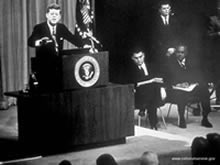
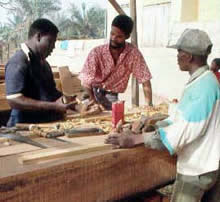
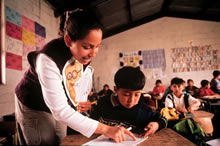
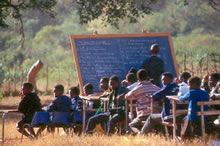
From left to right – US President John F. Kennedy in his state of the Union Address that initiated the Peace Corps – examples of volunteers participating in working and teaching Peace Corps programs in Ghana, Guatemala, and South Africa.
One of the most sensible political movements ever promoted was the Peace Corps; we weren’t surprised to learn that US President John F. Kennedy officially instigated it. The official website for today’s Peace Corps – www.peacecorps.gov has how the Peace Corps came into being.
The Peace Corps traces its roots and mission to 1960, when then Senator John F. Kennedy challenged students at the University of Michigan to serve their country in the cause of peace by living and working in developing countries. From that inspiration grew an agency of the federal government devoted to world peace and friendship.
Since that time, more than 187,000 Peace Corps Volunteers have been invited by 139 host countries to work on issues ranging from AIDS education to information technology and environmental preservation.
Today’s Peace Corps is more vital than ever, working in emerging and essential areas such as information technology and business development, and committing more than 1,000 new Volunteers as a part of the President’s Emergency Plan for AIDS Relief. Peace Corps Volunteers continue to help countless individuals who want to build a better life for themselves, their children, and their communities.
After learning about the founding of the Peace Corps we were surprised to discover that the concept began during the 1950s. Again an article on Wikipedia presents a comprehensive history of the Peace Corps:
Following the end of the Second World War, various members of the United States proposed bills to establish volunteer organizations in the Third World. In 1952 Senator Brien McMahon (D-Connecticut) proposed an “army” of young Americans to act as “missionaries of democracy”. Privately funded non-religious organizations began sending volunteers overseas during the 1950s.
Only in 1959, however, did the proposal for a national program of service abroad first receive serious attention in Washington when Congressman Henry S. Reuss of Wisconsin advanced the ideas of a “Point Four Youth Corps.” In 1960, he and Senator Richard L. Neuberger of Oregon introduced identical measures calling for a non-governmental study of the “advisability and practicability” of such a venture. Both the House Foreign Affairs Committee and the Senate Foreign Relations Committee endorsed the idea of a study, the latter writing the Reuss proposal into the Mutual Security legislation then pending before it. In this form it became law in June 1960. In August the Mutual Security Appropriations Act was enacted, making available $10,000 for the study, and in November ICA contracted with the Maurice Albertson, Andrew E. Rice, and Pauline E. Burkey of Colorado State University Research Foundation to make the study.
John F. Kennedy first announced his own idea for such an organization during the 1960 presidential campaign at a late-night speech at the University of Michigan in Ann Arbor on October 14. During a later speech in San Francisco, California on November 1, he dubbed this proposed organization the “Peace Corps”. Critics of the program (including Kennedy’s opponent, Richard M. Nixon) claimed the program would be nothing but a haven for draft dodgers. Others doubted whether college-aged volunteers had the necessary skills. The idea was popular among college students, however, and Kennedy continued to pursue it, asking respected academics such as Max Millikan and Chester Bowles to help him outline the organization and its goals. During his inaugural address, Kennedy again promised to create the program: “And so, my fellow Americans: ask not what your country can do for you — ask what you can do for your country”.
On March 1, 1961, Kennedy signed an Executive Order which officially started the Peace Corps. Concerned with the growing tide of revolutionary sentiment in the Third World, Kennedy saw the Peace Corps as a means of countering the notions of the “Ugly American” and “Yankee imperialism,” especially in the emerging nations of postcolonial Africa and Asia.
On March 4, Kennedy appointed his brother-in-law Sargent Shriver to be the program's first director. Shriver was tasked with fleshing out the organization, which he did with the help of Warren W. Wiggins and others. Shriver and his think tank outlined the three major goals of the Peace Corps and decided the number of volunteers they needed to recruit. The program began recruiting volunteers that following July.
Until about 1967, applicants to the Peace Corps had to pass a placement test that tested “general aptitude” (knowledge of various skills needed for Peace Corps assignments) and language aptitude. After an address from Kennedy, who was introduced by Rev. Russell Fuller of Memorial Christian Church, Disciples of Christ, on August 28, 1961, the first group of volunteers left for Ghana and Tanzania. The program was formally authorized by Congress on September 22, 1961 and within two years over 7,300 Peace Corps volunteers were serving in 44 countries. This number would jump to 15,000 in June of 1966, the largest number in the organization’s history.
Back to List at Top of Page
AMERICORPS
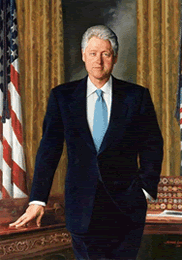
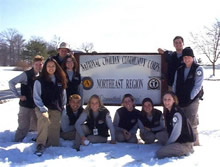
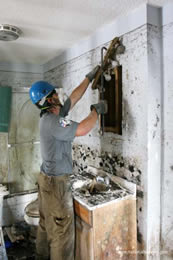
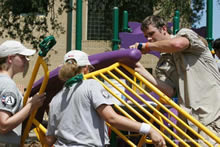
From left to right – Founder of AmeriCorps US President Bill Clinton – AmeriCorps volunteers as a group and volunteering in New Orleans
In seeing the response to Hurricane Katrina, one of the main organizations that kept being mentioned was AmeriCorps www.americorps.org In researching this Inspired Organization, we discovered that President Bill Clinton was front and center in its formation. On the official web site we found the information below:
September 1993 President Bill Clinton signs the National and Community Service Trust Act of 1993, creating AmeriCorps and the Corporation for National and Community Service to expand opportunities for Americans to serve their communities. VISTA and the National Civilian Community Corps become part of AmeriCorps, and the Foster Grandparent Program, the Retired and Senior Volunteer Program, and the Senior Companion Program are combined to create Senior Corps.
With passage of National and Community Service Act, Congress changes Retired Senior Volunteer Program to Retired “and” Senior Volunteer program to reflect that not all volunteers were retired.
Governor-appointed state service commissions are created to administer AmeriCorps funding at the state level.
1994
The Corporation for National and Community Service officially begins operation. Congress passes the King Holiday and Service Act of 1994, charging the Corporation for National and Community Service with establishing Martin Luther King Day as a day of service.
The Stanford Service-Learning Institute is created.
The Ford Foundation/United Negro College Fund Community Service Partnership Project (a 10-college program linking direct service and learning) begins.
Four National Civilian Community Corps campuses open in Aberdeen, MD; Charleston, SC; Denver, CO; and San Diego, CA.
September 1994
The first class of AmeriCorps members - 20,000 strong - begins serving in more than 1,000 communities. In swearing in these Americans, President Clinton says: “Service is a spark to rekindle the spirit of democracy in an age of uncertainty. When it is all said and done, it comes down to three simple questions: What is right? What is wrong? And what are we going to do about it? Today you are doing what is right - turning your words into deeds.”
1995
A study commissioned by the IBM Foundation, the Charles A. Dana Foundation, and the James Irvine Foundation finds that every federal dollar invested in AmeriCorps results in $1.60 to $2.60 or more in direct, measurable benefits to AmeriCorps members and the communities they serve.
The Service-Learning network is established on the Internet, via the University of Colorado Peace Studies Center.
The National Civilian Community Corps is included under AmeriCorps, becoming AmeriCorps*NCCC. The Aberdeen, MD, campus moves to Perry Point, MD.
April 1997
The Presidents’ Summit for America’s Future, chaired by General Colin Powell, brings together President Clinton, former Presidents Bush, Ford, and Carter, and Mrs. Reagan to encourage increased service and volunteerism to meet the needs of America's youth.
1997
AmeriCorps expands by introducing the Education Awards Program, which allows more organizations to join the service network -- nonprofits, faith-based organizations, colleges and universities, welfare-to-work programs, and other groups.
The Fourth of July Declaration on the Civic Responsibility of Higher Education and the
Wingspread Declaration Renewing the Civic Mission of the American University are published.
President Clinton and former President George Bush announce the resumption of the Daily Points of Light Award.
A fifth AmeriCorps*NCCC campus opens in Washington, D.C.
American Association of State Service Commissions (ASC) was launched.
1999
Since the program began, more than 100,000 AmeriCorps members have served 33 million people in 4,000 communities.
October 1999
AmeriCorps celebrates five years and 150,000 members. General Colin Powell, Utah’s Governor Mike Leavitt, Coretta Scott King, and Sargent Shriver join President Clinton at the White House to honor the winners of the first All*AmeriCorps awards.
Back to List at Top of Page
UNICEF
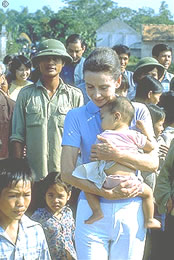
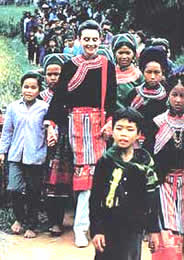
Audrey Hepburn as Ambassador for UNICEF
One of the most famous Inspired Organization for helping children is UNICEF (United Nations Children’s Fund) www.unicef.org and one of its most famous celebrity ambassadors was the late Audrey Hepburn. Once again it was an entry on Wikipedia, which enlightened us to this important Inspired Organization:
The United Nations Children’s Fund (or UNICEF) was created by the United Nations General Assembly on December 11, 1946 to provide emergency food and healthcare to children in countries that had been devastated by World War II. In 1953, UNICEF became a permanent part of the UN System and its name was shortened from the original United Nations International Children’s Emergency Fund but it has continued to be known by the popular acronym based on this old name. Headquartered in New York City, UNICEF provides long-term humanitarian and developmental assistance to children and mothers in developing countries.
A voluntarily funded agency, UNICEF relies on contributions from governments and private donors. Its programmes emphasize developing community-level services to promote the health and well-being of children. UNICEF was awarded the Nobel Peace Prize in 1965 and Prince of Asturias Award of Concord in 2006. In the United States, Canada and some other countries, UNICEF is known for its “Trick-Or-Treat for UNICEF” program in which children collect money for UNICEF from the houses they trick-or-treat at on Halloween night, sometimes instead of candy…
UNICEF is currently focused on 5 primary priorities: Child Survival and Development, Basic Education and Gender Equality (including girls’ education), Child protection from violence, exploitation and abuse, HIV/AIDS and children, and Policy advocacy and partnerships for children’s rights. Related areas of UNICEF action include early childhood development, adolescence development and participation, life skills based education and child rights all over the world…
Education is a proven intervention for improving the lives of all people, including children. Educating young women yields spectacular benefits for the current and future generations, and specifically affects a range of UNICEF priorities including child survival, children in family, immunization, and child protection.
UNICEF’s aim is to get more girls into school, ensure that they stay in school and that they are equipped with the basic tools they need to succeed in later life. As part of its on-going efforts to ensure every girl and boy their right to an education, UNICEF’s acceleration strategy is speeding progress in girls’ enrollment in 25 selected countries during the 2002–2005 period. Period.
Immunization is a direct intervention method which has made great improvements in the health of children world-wide over the past 20 years. But every year, more than 2 million children die from diseases that could have been prevented by inexpensive vaccines.
The plus in the programme is the additional immunizations made possible during interventions. Ranging from client education to nutritional supplements to insecticide-treated mosquito netting, these life-saving services make immunization programmes a powerful tool for child health.
UNICEF uses the term ‘child protection’ to refer to preventing and responding to violence, exploitation and abuse against children and teens up to 18 yrs – including commercial sexual exploitation, trafficking, child labour and harmful traditional practices, such as female genital mutilation/cutting and child marriage. UNICEF’s child protection programmes also target children who are uniquely vulnerable to these abuses, such as when living without parental care, in conflict with the law and in armed conflict. Violations of the child’s right to protection take place in every country and are massive, under-recognized and under-reported barriers to child survival and development, in addition to being human rights violations. Children subjected to violence, exploitation, abuse and neglect are at risk of death, poor physical and mental health, HIV/AIDS infection, educational problems, displacement, homelessness, vagrancy and poor parenting skills later in life. Among many other programmes, UNICEF supports the international Child Rights Information Network. In 2007, UNICEF published An Overview of child well-being in rich countries, which showed the UK and the USA at the bottom of a league of 21 economically advanced nations when it comes to overall child well-being.
15 million children are now orphaned due to AIDS. It is estimated that by the year 2010 in sub-Saharan Africa alone, more than 18 million children will have lost at least one parent to AIDS. Half of all new infections are people under the age of 25, with girls hit harder and younger than boys. Working to protect and support orphaned children, legal environment. UNICEF is also running several programmes dedicated to controlling both online and off-line child pornography.
Every child must be ensured the best start in life – their future, and indeed the future of their communities, nations and the whole world depends on it.
UNICEF applies a holistic, evidence-based approach to Early childhood, including the following principles:
- Preventive and curative health care including immunization, adequate nutrition, and safe water and basic sanitation must be provided as a sine qua non.
The heart of UNICEF’s work is in the field, with staff in over 150 countries and territories. More than 120 country offices carry out UNICEF’s mission through a unique program of cooperation developed with host governments. Seven regional offices guide their work and provide technical assistance to country offices as needed.
Overall management and administration of the organization takes place at its headquarters in New York. UNICEF’s Supply Division is based in Copenhagen and serves as the primary point of distribution for such essential items as lifesaving vaccines, antiretroviral medicines for children and mothers with HIV, nutritional supplements, emergency shelters, educational supplies, and more.
Many people in industrialized countries first hear about UNICEF’s work through the activities of 37 National Committees for UNICEF. These non-governmental organizations are primarily responsible for fund raising, selling UNICEF greeting cards and products, creating private and public partnerships, advocating for children’s rights, and providing other invaluable support. The U.S. Fund for UNICEF is the oldest of the National Committees, founded in 1947.
UNICEF is supported entirely by voluntary funds. Governments contribute two thirds of the organisation's resources; private groups and some 6 million individuals contribute the rest through the National Committees.
Guiding and monitoring all of UNICEF's work is a 36-member Executive Board which establishes policies, approves programs and oversees administrative and financial plans. The Executive Board is made up of government representatives who are elected by the United Nations Economic and Social Council, usually for three-year terms.
Back to List at Top of Page
THE WILLIAM J. CLINTON FOUNDATION

From left to right – Archbishop Desmond Tutu – President Bill Clinton & Afghanistan president Hamid Karzai –The Clinton Global Initiative is making a difference by matching good ideas with the people who can implement them.” — William J. Clinton
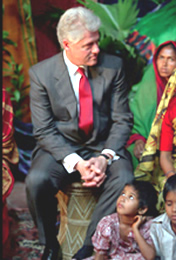
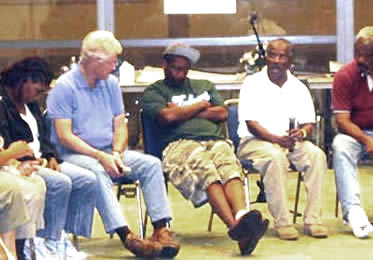
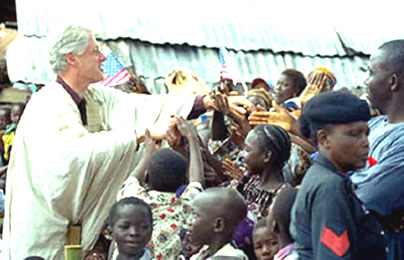
From left to right – President Bill Clinton meets with villagers in Dhaka Bangladesh, March 2000, Hurricane survivors in Baton Rouge October 2005 & greeting village children in Ushafa, Nigeria, 2000
When we heard of President Clinton’s Global Initiative, we saw how lives could be changed dramatically, with very little help. However, we feel that The William J. Clinton Foundation web site – www.clintonfoundation.org is the most valuable source for information about the foundation’s activities. We found this statement of the foundation’s mission on the site:
In 2005, President Clinton launched the Clinton Global Initiative (CGI), a non-partisan project of the Clinton Foundation, bringing together global leaders, business executives, NGO pioneers, and others to address some of the world’s most pressing challenges. Through its emphasis on results, CGI creates more than just an opportunity for discussion: each participant is asked to undertake a specific action—called a Commitment to Action—in one particular CGI focus area. Commitments to Action can be monetary or non-monetary, taking a variety of forms including investments, in-kind donations, expertise, services, volunteer time, or other support. Throughout the year, CGI staff monitors the progress of commitments and helps members develop ideas for future commitments.
CGI neither gives grants nor receives donations to carry out projects. Instead, it facilitates collaboration, matching people who have resources with those who can achieve results in the field.
Members—
Participation is by invitation only, limited to a select and diverse group of heads of state, CEOs, media voices, philanthropists and foundation executives, religious leaders, directors of non-profit organizations, and other original thinkers. When choosing individuals for membership, CGI seeks to create a rich tapestry of people who are resourceful, innovative, and distinguished by their record of social action and potential to solve problems. In addition, CGI aims to acquire a membership representative of the many world regions that CGI touches. Participation is limited to approximately 1,000 individuals.
Back to List at Top of Page
THE CARTER CENTER
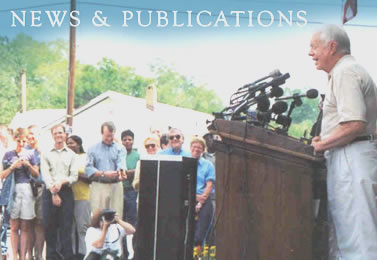
President Jimmy Carter
It was no surprise to see President and Nobel Laureate Jimmy Carter continue his peacemaking efforts when he left office. Moreover, it was no surprise to see him receive the Nobel Peace Prize in 2002 for his efforts. Nonetheless, it is through the work of his and former First Lady Rosalynn Carter’s foundation that he has achieved the most. On The Carter Center web site www.cartercenter.org we found this statement about the foundation’s mission:
The Carter Center: Creating a world in which every man, woman, and child has the opportunity to enjoy good health and live in peace
The Carter Center, in partnership with Emory University, is committed to advancing human rights and alleviating unnecessary human suffering. Founded in 1982 by former U.S. President Jimmy Carter and former First Lady Rosalynn Carter, the Atlanta-based Center has helped to improve the quality of life for people in more than 70 countries.
Led by the Carters and an independent board of trustees, the Center's staff wage peace, fight disease, and build hope by both engaging with those at the highest levels of government and working side by side with poor and often forgotten people.
In this way, the Center has strengthened democracies in Asia, Latin America, and Africa; helped farmers double or triple grain production in 15 African countries; mediated or worked to prevent civil and international conflicts; intervened to prevent unnecessary diseases in Latin America and Africa, including the near eradication of Guinea worm disease; and strived to diminish the stigma against mental illness. A not-for-profit, nongovernmental organization, the Center's work is supported by donations from individuals, foundations, corporations, and countries.
Our Mission—
The Carter Center, in partnership with Emory University, is guided by a fundamental commitment to human rights and the alleviation of human suffering; it seeks to prevent and resolve conflicts, enhance freedom and democracy, and improve health. While the program agenda may change, The Carter Center is guided by five principles:
- The Center emphasizes action and results. Based on careful research and analysis, it is prepared to take timely action on important and pressing issues.
- The Center does not duplicate the effective efforts of others.
- The Center addresses difficult problems and recognizes the possibility of failure as an acceptable risk.
- The Center is nonpartisan and acts as a neutral in dispute resolution activities.
- The Center believes that people can improve their lives when provided with the necessary skills, knowledge, and access to resources.
The Carter Center collaborates with other organizations, public or private, in carrying out its mission.
Back to List at Top of Page
WIKIPEDIA & GNU / Creative Commons -Free Documentation Licenses
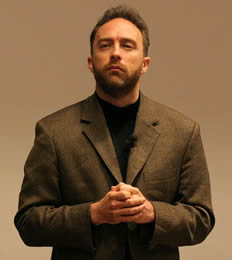
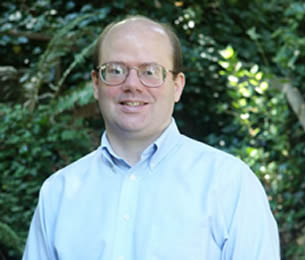
From left to right Jimmy Wales and Larry Sanger
As the information about the various Earth Angels was derived from Wikipedia, we include them as an Inspired Organization. It seems that two men were responsible for this valuable resource. Nonetheless, appropriately it is the Wikipedia web site www.Wikipedia.org that provides the information about how Wikipedia was created.
We would like to extend a special thank you to the Wikipedia web site and owners for the many graphics and verbage entries that are used on this web site. To stay in complience with the GNU Free documentation License, we have printed it below as a reference and will link to it when applicable.
I, the copyright holder of this work, hereby publish it under the following license:
|
Below is the list on Wikipedia for Creative Commons.org Attribution-ShareAlike 2.5 License. The Graphics used under this License will link here.
This work is licensed under the Creative Commons Attribution-ShareAlike 2.5 License. |
Below is the list on Wikimedia Commons for Creative Commons.org Attribution-ShareAlike 3.0 License. The Graphics used under this License will link here.
|
 |
This is a file from the Wikimedia Commons. Information from its description page there is shown below. |
Wikipedia, a project to produce a free content encyclopedia that can be edited by anyone, formally began on 15 January 2001 as a complement to the similar, but expert-written, Nupedia project. It quickly replaced Nupedia, growing to become a large global project…
As of September 2007, Wikipedia had approximately 8.2 million articles in 253 languages, comprising a combined total of over 1.41 billion words for all Wikipedias. The English Wikipedia edition passed the 2,000,000-article mark on September 9, 2007 with a total of over 609 million words, roughly fifteen times as many as the largest edition of Encyclopædia Britannica. Wikipedia’s articles have been written collaboratively by volunteers around the world and the vast majority of them can be edited by anyone with access to the Internet. Steadily rising in popularity since its inception, it currently ranks among the top ten most-visited websites worldwide. Wikipedia’s name is a portmanteau of the words wiki (a type of collaborative website) and encyclopedia. Its main servers are in Tampa, Florida, with additional servers located in Amsterdam and Seoul…
The concept of gathering all of the world’s knowledge in a single place goes back to the ancient Library of Alexandria and Pergamon, but the modern concept of a general purpose, widely distributed, printed encyclopedia dates from shortly before Denis Diderot and the 18th century encyclopedists. The idea of using automated machinery beyond the printing press to build a more useful encyclopedia can be traced to H. G. Wells’ book of essays World Brain (1937) and Vannevar Bush’s future vision of the microfilm based Memex in As We May Think (1945). Another milestone was Ted Nelson’s Project Xanadu in 1960.
With the development of the web, many people attempted to develop Internet encyclopedia projects. Free software exponent Richard Stallman described the usefulness of a “Free Universal Encyclopedia and Learning Resource” in 1999. He described Wikipedia’s formation as “exciting news” and his Free Software Foundation encourages people “to visit and contribute to the site”. One little-acknowledged predecessor was the Interpedia, which Robert McHenry has linked conceptually to Wikipedia…
Wikipedia was founded as a feeder project for Nupedia, an earlier (now defunct) project founded by Jimmy Wales to produce a free encyclopedia. Nupedia had an elaborate multi-step peer review process, and required highly qualified contributors. The writing of articles was slow throughout 2000, the first year that project was online, despite having a mailing-list of interested editors and a full-time editor-in-chief, Larry Sanger.
During Nupedia’s first year, Wales and Sanger discussed various ways to supplement Nupedia with a more open, complementary project…
Back to List at Top of Page
SUBMITTALS by Sherri Zimmerman
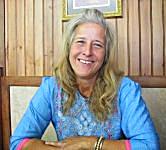
Sherri Zimmerman at: www.imaginepeacenow.com
Sherri is the first person to send us individuals to add to the Earth Angels list of people making a difference. Thank you Sherri for making a difference and we have added your comments about these wonderful people in (“ ”) below the descriptions of their Organizations. We encourage you to visit their web sites as well for more information.
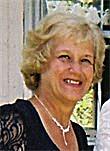 Sandy Musser— The Musser Foundation: www.sandymusser.com
Sandy Musser— The Musser Foundation: www.sandymusser.com
Sandy's adoption activist work began in 1976, which was the year she joined the Adoption Forum of Philadelphia. That same year, Sandy was invited to speak to The Children's Bureau in Wilmington, Delaware and asked to share her birthmother experience with social workers and adoptive parents. Little did she realize that many years later she would be sent to Federal Prison because of her strong dedication, commitment and determination to the cause of Adoption Reform.
“I experienced through Sandy and The Musser Foundation the amazing power of one woman who fought with everything she had left within for every thing she believed in.”
Jim De Maio— Helping Ministry: www.helpingministry.com
Helping Ministry was founded in May 2001. It is a member of The Association for the Integration of the Whole Person, (AIWP) a non-profit organization (#95-3455451).
Jim holds a Masters Degree in Mental Health counseling and is a Certified Addictions Professional with the Florida Certification Board. He was born and raised on Long Island where he completed his undergraduate studies in philosophy at Stonybrook University (SUNY). His Masters Degree was earned in 1980 from Wright State in Dayton Ohio. Jim was ordained a minister by AIWP in 2001.
“Helping Ministry is inclusive pertaining to all beliefs and to all people. No one is ever turned away due to no or little money. Imagine —a healing center for the soul— this is what I love about it and know of it.”
Back to List at Top of Page
Back to Top


